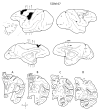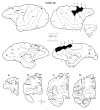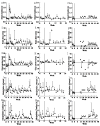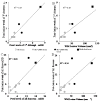Volumetric effects of motor cortex injury on recovery of dexterous movements
- PMID: 19679127
- PMCID: PMC2778269
- DOI: 10.1016/j.expneurol.2009.07.034
Volumetric effects of motor cortex injury on recovery of dexterous movements
Erratum in
- Exp Neurol. 2010 Mar;222(1):171
-
Corrigendum to "Volumetric effects of motor cortex injury on recovery of dexterous movements" [Experimental Neurology 220 (2009) 90-108].Exp Neurol. 2021 Aug;342:113701. doi: 10.1016/j.expneurol.2021.113701. Epub 2021 Mar 19. Exp Neurol. 2021. PMID: 33814120 No abstract available.
Abstract
Due to the heterogeneous nature of most brain injuries, the contributions of gray and white matter involvement to motor deficits and recovery potential remain obscure. We tested the hypothesis that duration of hand motor impairment and recovery of skilled arm and hand motor function depends on the volume of gray and white matter damage of the frontal lobe. Lesions of the primary motor cortex (M1), M1 + lateral premotor cortex (LPMC), M1 + LPMC + supplementary motor cortex (M2) or multifocal lesions affecting motor areas and medial prefrontal cortex were evaluated in rhesus monkeys. Fine hand motor function was quantitatively assessed pre-lesion and for 3-12 months post-lesion using two motor tests. White and gray matter lesion volumes were determined using histological and quantitative methods. Regression analyses showed that duration of fine hand motor impairment was strongly correlated (R(2)>0.8) with the volume of gray and white matter lesions, with white matter lesion volume being the primary predictor of impairment duration. Level of recovery of fine hand motor skill was also well correlated (R(2)>0.5) with gray and white matter lesion volume. In some monkeys post-lesion skill exceeded pre-lesion skill in one or both motor tasks demonstrating that continued post-injury task practice can improve motor performance after localized loss of frontal motor cortex. These findings will assist in interpreting acute motor deficits, predicting the time course and expected level of functional recovery, and designing therapeutic strategies in patients with localized frontal lobe injury or neurosurgical resection.
Figures










References
-
- Alaverdashvili M, Moon SK, Beckman CD, Virag A, Whishaw IQ. Acute but not chronic differences in skilled reaching for food following motor cortex devascularization vs. photothrombotic stroke in the rat. Neuroscience. 2008;157:297–308. - PubMed
-
- Battaglini PP, Muzur A, Galletti C, Skrap M, Brovelli A, Fattori P. Effects of lesions to area V6A in monkeys. Exp Brain Res. 2002;144:419–422. - PubMed
-
- Binkofski F, Seitz RJ, Hacklander T, Pawelec D, Mau J, Freund HJ. Recovery of motor functions following hemiparetic stroke: a clinical and magnetic resonance-morphometric study. Cerebrovasc Dis. 2001;11:273–281. - PubMed
-
- Black P, Cianci SN, Markowitz RS. Differential recovery of proximal and distal motor power after cortical lesions. Trans Am Neurol Assoc. 1971;96:173–177. - PubMed
-
- Bucy PC. Organization of the central nervous control of muscular activity. Bull Chic Med Soc. 1949;51:863–866. - PubMed
Publication types
MeSH terms
Grants and funding
LinkOut - more resources
Full Text Sources
Medical

